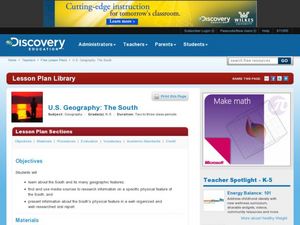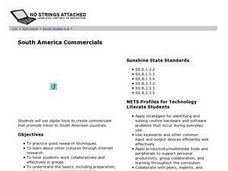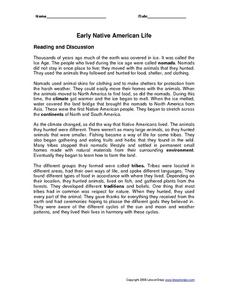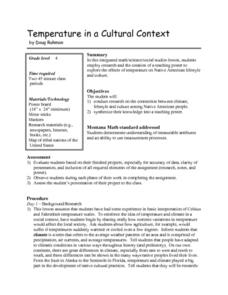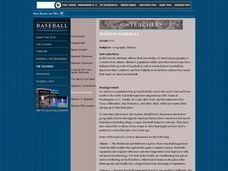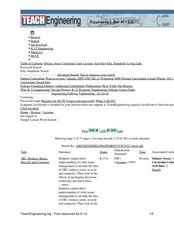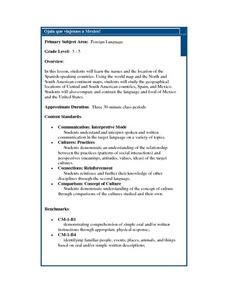Curated OER
U.S. Geography: The South
Young geographers complete a research project. They list the physical features found in the American South. They then discuss the economy, culture, and geography found in the South. They work in groups to research one of the five...
Curated OER
Travel by Train: South American DVD Assignment
In this geography skills worksheet, students watch the National Geographic video "Travel by Train." Students then respond to 18 short answer questions about content in the video about South America.
Curated OER
South America Commercials
Students create commercials that promote travel to South American countries in this middle-level lesson for the Social Studies classroom. The lesson suggests using educational software including MS Word, MS Powerpoint, and MS Publisher.
Curated OER
Early Native American Life
In this Native Americans learning exercise, students read and discuss a 1 page article, fill in the blanks to 6 statements, match 6 vocabulary words with their correct definitions and answer 4 short answer questions referring back to the...
Curated OER
AFRICAN-AMERICAN HOMESTEADERS
Students analyze the factors that inhibited and fostered African American attempts to improve their lives during Reconstruction, the role of class, race, gender, and religion in western communities, and the challenges diverse people...
Curated OER
Traveling as an Ancient American
What would you bring on a trip...if you had to carry it all through freezing temperatures for 3 months? Historians consider this question, faced with their family's need to move south for warmer temperatures in the ancient world....
Curated OER
Third Grade Social Studies- Quiz
In this social studies worksheet, students complete a 25 question multiple choice quiz about early American colonial life and the Cherokee and other Native American tribes.
Curated OER
Temperature in a Cultural Context
Fourth graders investigate the effects of temperature on Native American lifestyle and culture. In small groups they conduct research on cultural practices showing a connection to the climate and create a poster displaying their...
Curated OER
How Much is There to Eat?
Pupils examine food production related to population density. In this interdisciplinary instructional activity, students gather data regarding food production in the American South and in India. Pupils follow the outlined steps to...
Curated OER
Commonalities and Differences from Africa to Cleveland as Evidence Through the Gullah Community Connection
Students explore Afro-American history. They identify the commonality between African, Carolinian and Cleveland Black culture. Students explore the water cycle, oceanography, hydrology and bio-geochemical processes. They discuss the...
Curated OER
Mapping Baseball
Students research how climate, distance, population shifts and immigration have influenced American baseball. They also consider how players from other countries have made their mark on American baseball.
Curated OER
Differences in Location Lesson Plan: Treatment of Early African Americans
Young scholars reach The Domestic Slave Trade, then examine the differences between the people enslaved in North America as opposed to those in Brazil.
Curated OER
Baltimoreans in the California Gold Rush
Eleventh graders explore the reasons for migration to California during the Gold Rush. In this American History lesson, 11th graders read letters about the opportunities and obstacles people faced. Students create a map of...
Curated OER
Earthquake of 1964
Students examine the damage from the earthquake across a large geographic area of Alaska. They discover additional damage occurred from the tsunami, fires, and flooding after the initial earthquake. They collect images and information...
Curated OER
AT YOUR FINGERTIPS
The student will locate countries on a world map from which we import foods that our climate prevents us from growing locally.1. Discuss the term "export." Divide students into groups of four. Give the groups
five minutes to brainstorm...
Curated OER
Cabeza de Vaca Meets the Coahuiltecans
Students examine the difference between primary and secondary sources by examining the journal of Cabeza de Vaca and creating a poster about the Coahuitecan Indian groups. They portray a scene of the groups in 16th Century south Texas.
Curated OER
Thar She Blows
Students discover the effects of El Nino on the global climate. As a class, they role play the role of a cold or warm wind and act out a skit in front of the class. They discuss the results of the role play once it is completed.
Curated OER
Fifth Grade Social Studies
In this social studies activity, 5th graders answer multiple choice questions about World War II, the transcontinental railroad, slavery, and more. Students complete 25 questions.
Montana State University
Meet Mount Everest
Learning about one landform might seem boring to some, but using the resource provided practically guarantees scholar interest. The second in a sequential series of eight covering the topic of Mount Everest includes activities such as a...
Curated OER
Ojala que viajemos a Mexico!
Students research the names and locations of Spanish speaking countries throughout the world. They use a world map to become familiar with the locations of these countries and use the Internet to conduct further research. They sing...
Curated OER
A Day in the Life of a San Francisco Native Animal
Students write from an animal's perspective. In this writing instructional activity students explore the landscape of San Francisco prior to the arrival of the explorers. Students research animals indigenous to the area.
Curated OER
Climate Change in Canada
In this Canada worksheet, students read a 6 page detailed informational text about climate change in Canada. Students then complete 10 essay/short answer questions.
Curated OER
World Map and Globe
Young scholars locate and identify continents and countries. In this world map lesson, students locate and identify one country on each continent.
Curated OER
New Mexico
In this New Mexico instructional activity, students read a two page text about the history of the state of New Mexico. Students answer ten true and false questions.


